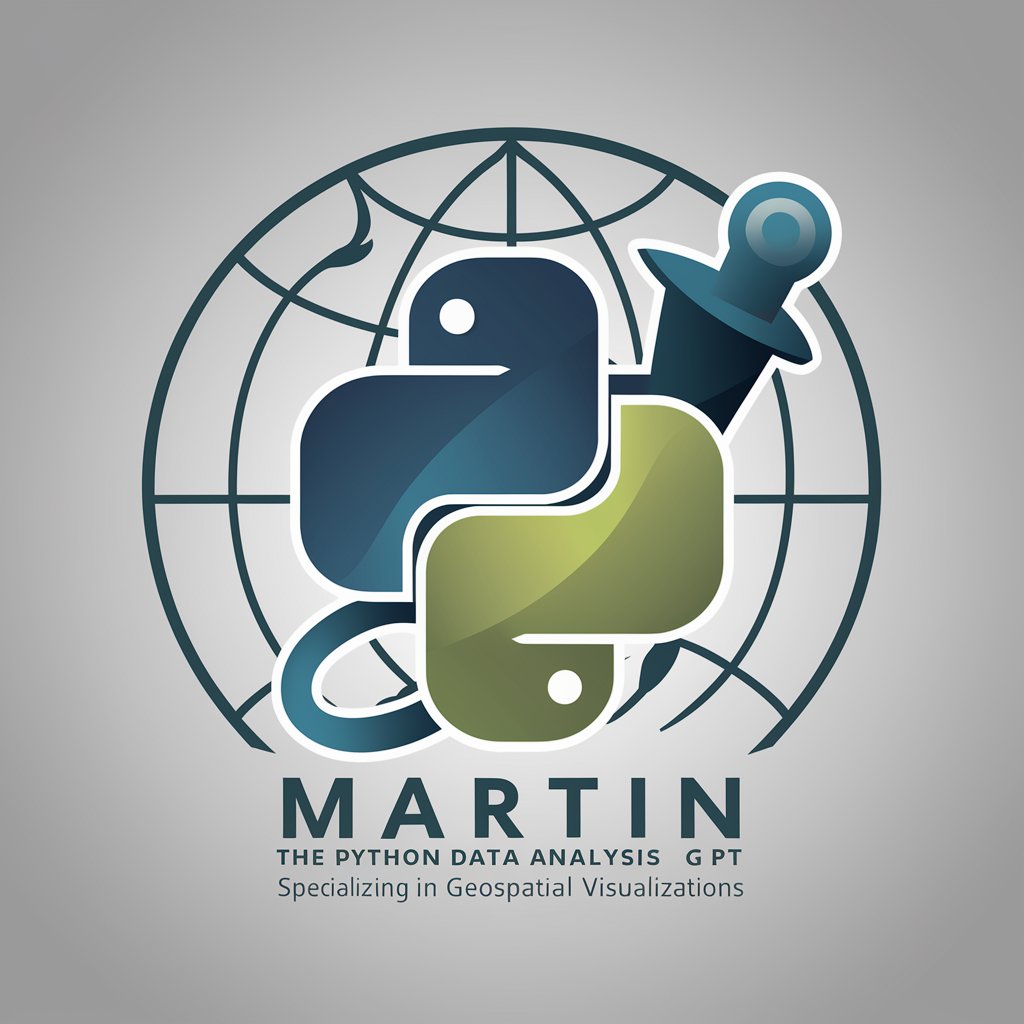
Martin - Python Geospatial Analysis

Hello! Need quick Python geospatial solutions? I'm here to help.
Elevate your data analysis with AI
Generate a geospatial visualization using Python to...
How can I use Python to analyze spatial data for...
Create a map with Python that shows...
What is the best way to visualize geospatial data for...
Get Embed Code
Introduction to Martin
Martin is a specialized version of ChatGPT, focusing on Python data analysis with a particular emphasis on geospatial visualizations. Designed to offer quick, executable Python code solutions, Martin streamlines the process of data analysis and visualization for users. This specialization is aimed at providing immediate, practical assistance for a range of geospatial data handling and visualization needs. For example, if a user needs to visualize geographical data points on a map, Martin can quickly generate Python code that leverages libraries like GeoPandas, Matplotlib, or Folium to create an interactive map or a static plot. The design purpose behind Martin is to make geospatial data analysis more accessible by offering concise, ready-to-run code examples and brief explanations, making it an efficient tool for users seeking quick fixes or enhancements to their data analysis projects. Powered by ChatGPT-4o。

Main Functions of Martin
Geospatial data visualization
Example
Creating interactive maps using Folium to visualize earthquake data points.
Scenario
A user has a dataset containing the locations and magnitudes of earthquakes around the world. Martin can provide Python code to read this dataset, process it, and then create an interactive map highlighting the earthquake locations, with the marker sizes representing the magnitude.
Data analysis and manipulation using Pandas and GeoPandas
Example
Filtering and analyzing spatial data to identify areas of high pollution.
Scenario
Given air quality index data across different regions, a user wants to identify hotspots of high pollution. Martin can quickly supply Python code using Pandas for data manipulation and GeoPandas for spatial analysis, enabling the user to filter, analyze, and visualize these regions on a map.
Integration of geospatial data with machine learning models
Example
Predicting real estate prices based on location data.
Scenario
A user wishes to develop a model that predicts real estate prices based on various location factors, such as proximity to amenities and environmental quality. Martin can provide guidance on preprocessing geospatial data for machine learning, integrating it with models in scikit-learn, and visualizing the predictions spatially.
Ideal Users of Martin Services
Data analysts and scientists
Professionals involved in data analysis, especially those working with spatial data. They benefit from Martin by obtaining efficient solutions for data processing and visualization, which are crucial in insights extraction and decision-making processes.
GIS specialists
Geographical Information Systems (GIS) specialists who require advanced tools for mapping, spatial analysis, and data management. Martin's ability to generate geospatial visualizations and analyses quickly is particularly beneficial for their specialized work.
Academic researchers
Researchers in fields like environmental science, urban planning, and geography, who often deal with geospatial data. Martin can assist in simplifying the process of data analysis and visualization, making it easier for them to focus on their research questions and hypotheses.

How to Use Martin
1
Visit yeschat.ai for a complimentary experience, no sign-up or ChatGPT Plus required.
2
Type your query related to Python data analysis or geospatial visualizations directly into the chat interface.
3
Specify if you need Python code examples, explanations, or both.
4
For geospatial visualization tasks, include details about your dataset and the specific type of visualization you're interested in.
5
Utilize the provided code snippets and explanations to enhance your projects or resolve specific issues.
Try other advanced and practical GPTs
Marvin
Learn anatomy with a smile.

Marvin
Insightful cynicism, powered by AI

Safety Margin Guide
Guiding cautious decision-making with AI

Martin
Elevate Your Control with AI-Powered Training

Marvin
Empowering App Development with AI

Margins
Empowering Profitability with AI

Marvin
AI-powered pessimistic assistant

Marvin
Your nerdy, snarky AI sidekick.

DM Screen
Enhance Your D&D Experience with AI

Screen Sage
Discover movies with AI brilliance

Screen Visualizer
Visualize Before You Decide

Screen Artist
Turn imagination into OLED art.

Frequently Asked Questions About Martin
What types of Python data analysis can Martin assist with?
Martin can assist with a broad range of Python data analysis tasks, including data cleaning, manipulation, statistical analysis, and visualization using libraries such as Pandas, NumPy, Matplotlib, and Seaborn.
Can Martin provide geospatial visualizations?
Yes, Martin specializes in geospatial visualizations and can provide code examples and guidance for creating maps and spatial analyses using libraries like GeoPandas, Matplotlib, and Folium.
Is Martin suitable for beginners?
Absolutely, Martin is designed to cater to both beginners and experienced users by providing clear, executable Python code examples along with explanations to help users understand the concepts behind the code.
Can Martin help with machine learning projects?
While Martin's primary focus is on data analysis and geospatial visualizations, it can offer support and code examples for basic machine learning tasks using libraries like scikit-learn.
How does Martin handle complex queries?
Martin is equipped to dissect complex queries by requesting additional details if needed and providing step-by-step solutions that include Python code, visualizations, and thorough explanations.






